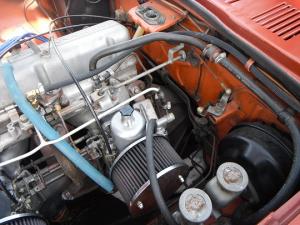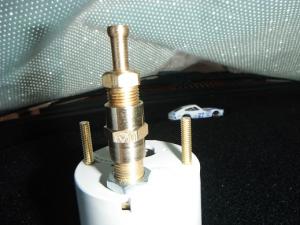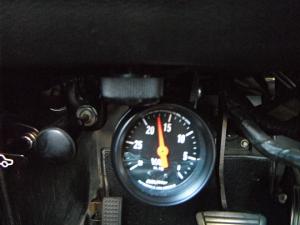Everything posted by Stanley
-
Tuning this 3.0 on SUs...
Still using the SS needles? From the chart posted, looks like they have an interesting profile, like custom needles, going richer at top end (where it needs more gas, and bottom (for when you suddenly floor it from cruise and the piston drops due to reduced vacuum). Can't find data on stock N27's. Measured them with my $10 micrometer, but would like to compare with the official numbers. Recently installed a vacuum gauge under the dash, it's interesting to watch what is does while driving. Makes it easier to understand what the SU experts are talking about (Blue's SU mod thread, for example). Since the SU piston and needle position depends on vacuum, watching the gauge allows me accelerate without the engine missing or popping. When I see the vacuum drop to about 5 in/hg (with SM needles) I back off the throttle a little, since that's where it happens. When the revs are high, the vac stays high, and throttle position has less effect on vacuum. Obviously, this isn't what most drivers get from a vacuum gauge (hope to eventually learn that stuff too). Since 5 in/hg is lower than the vac at idle (about 15) maybe I can figure where that is on the needle (probably very close to the base) and polish that down, to tune out the miss and still not be too rich at cruise and idle. Regarding the hard starting, maybe more friction in engine in the first half of break-in period?
-
Hard line between mech fuel pump and SU
It's a Kyosan, got it (rebuilt) at Autozone a few years ago. Now they only have the stamped metal ones. Seems like there must be some around on the shelves of some warehouses. I ordered one from Napa that they said was OEM type, picture in their catalog was old style, but it wasn't. The part numbers are the same so can't tell from that. Called Rock Auto to ask about it, they said they had old style as shown in their online catalog, but couldn't open the box and look before sending it, so I declined. Couple days later the picture was gone from their catalog, guess they were heads-up enough to go check and revise it.
-
What would you do to your 240z if on a $3500 budget?
First thing I did when I bought Z about 7-8 years ago was put a new windshield. I think it was $150 plus $10 tip including installation, probably more now. Makes a huge difference. Next thing was Tokico's, and MSA's poly suspension set (with certain rubber bushings recommended by MSA for street) also big difference. Cost about $1200 for struts and suspension parts and professional installation by quality shop, they also replaced cracked transmission mount. Bumpers seem crazy expensive. Stainless JDM style available from Canada for $1200 plus shipping for front and rear. It was $700 to chrome a used one with overider and guards when I got rear-ended, but the other guy's insurance paid for it. So $1200 for both sounds less horrible. Finding '73 bumpers is harder.
-
Hard line between mech fuel pump and SU
The outlet hose barb on my rebuilt OEM mechanical fuel pump turned out to be BSPT/BSPP, 1/8" thread. 1/8" NPT would not thread in at all. Got the BSPT to NPT adapter from McMaster-Carr, also an NPT Tee for the hose barb to the fuel line and my AN (with NPT adapters) hose to the F.P. gauge. A little complicated but it works. SU fittings are metric. Should be standard metric banjo bolts available with threaded (maybe AN) inlets. Seen them on a few Z cars. I can imagine a setup that would make it difficult to remove the float bowl lids. I had to remove and replace the lids many times to adjust the floats the way I like.
-
What hose for vacuum gauge?
Good tips at the link you posted. With all those ports on the balance tube you could have a vac gauge on it, and one in the car without cutting into any essential hoses. I'm thinking the gauge may be a help to carb tuning. Piston position in the carbs depends on vacuum (modified short-term by dashpot oil), and I expect it would be at the same height at the same vacuum at idle or under load. So if there's a lean condition confirmed by miss or other means at a certain steady-state rpm on the road, it might be possible to note the vac reading at that time and later see the piston position (at idle with the air cleaners off) at the rpm that gives the same vac reading. Then you'd know what part of the jet needles to modify. Unless I'm missing something. Hooked up my F.P. gauge with regard to safety; I could probably pull a small trailer with it, the AN line is rated for tension. Wouldn't trust an inferior gauge or one with hose barb connections inside the car, though. Found an unexpected benefit from the gauge; when the gas tank gets real empty, the gauge shows a drop in fuel pressure before you run out of gas, so you know to stop at the next station.
-
What hose for vacuum gauge?
Here's a few shots. Used 7/32" vac line, found some smooth hose barbs to fit. Used a little Permatex "aviation" on everything. Put some wirecare braid sleeve on it for looks. Didn't bother hooking up the light. Took a drive to check it out, car ran really crappy, my first thought was the gauge messed it up somehow. Had the symptoms of fouled plugs, though, so pulled the plugs and sure enough the back three were fouled. Cleaned them off and set the back carb a little leaner, took another drive and it ran well. The vacuum gauge works fine, but I'd be afraid to put an automotive mechanical fuel pressure gauge in the cockpit (industrial gauges are all metal, made in USA or Germany, repairable, with tempered glass faceplates good for 200 psi, bourdon tubes good for 3 times max pressure on gauge, etc.). Maybe there are better automotive gauges I don't know about. Vacuum really drops out on acceleration, guess the SU pistons are dropping as well. Learning experience.
-
Tuning this 3.0 on SUs...
http://www.improvedtouring.com/forums/showthread.php?23288-Which-Intake-Manifold-for-a-240Z Found this today, interesting bit about dashpot oil, piston rise etc.; about racing with stock engines.
-
What Are These Holes For?
Kind of off topic, but don't want to start a new thread. It worked! Used a 1.25 dia rubber fender washer with a 5/16" hole from ACE hardware. Clipped shoulder belt onto the lap belt and stretched the rubber washer over the fitting. Takes about 10 seconds. Needs to be a thin washer to fit under the little carriage bolt thing. Works perfect. Tried to make it unclip but couldn't. A nylon washer would be more work and not as good. Can't sling the unclipped belt over my shoulder as a ticket preventer anymore, but that's not a great idea anyway.
-
What Are These Holes For?
On my 73 the shoulder belt unclips from the lap belt sometimes if it (the shoulder belt) is not tightened enough. It happened on the freeway a few times before I figured out that it needs to be tightened. But when I make a stop and take off the belt, it often unclips itself. Haven't tried it yet, but it seems like you could cut a nylon washer and slip it over the connector that goes through the lap belt, so it wouldn't do that.
-
What hose for vacuum gauge?
I expect you're right, the reason I'm rejecting the tiny plastic tube is a number of online reviews for the Autometer vac gauge, that stated their gauges didn't work until they replaced the plastic with real vacuum hoses. Problem seems to be that they kink very easily, and can't be un-kinked. I have a McDaniel industrial fuel pressure gauge in the cockpit, with a 1100 psi AN hose to the mechanical fuel pump, and a quick release so I can remove it in 30 seconds if the dragstrip tech crew has a beef with it (doubt if they would for a 16 second car). Looking at my new vac gauge, I have to say there's no comparison between industrial gauges and the automotive gauges that I've seen. Industrial gauges are much better quality. They have to be. They only cost a little more. I wanted the gauge to match the look of the stock gauges, maybe a dumb decision, we'll see.
-
What hose for vacuum gauge?
The gauge and pod showed up today. It's 2 1/16" diameter, and when I held it up next to the clock it looks to small to fit in there as is. No big deal though, it can chill under the dash, next to the adjusting knob for the trip odometer. Way easier than doing the clock thing. Now I'm glad it's small. The 1/8" plastic tube that came with it is 1/8" O.D. Will toss it and use 1/8" (I.D.), 3/16" or 1/4" rubber or silicon vacuum line to a 1/4" BSPT/NPT adapter (from a previous unfinished project) on the balance tube. Might try a couple different hoses to see if there's a difference. Still trying to understand that hybridz analysis of the performance of different hose sizes. I had to study pipe flow once to pass a test but I forgot all that stuff. Seems like the air in a large hose (consider an extremely large hose) would act as a buffer, slowing down response. For a very small hose, friction against the walls would slow down response. Could too large and too small hoses both slow down response? Seems unlikely, but maybe.
-
Should I Buy a 260z or hold out for something else?
Maybe prices are higher on the East coast, but here you could get a Z that runs for that money. 260's are OK, but if it's not running it's hard to know if it needs a tuneup or a new engine. Can't check the brakes, clutch, turn signals, etc. If it was well maintained, garaged, etc., then maybe it's worth it, but if so why isn't it running? Regarding restoration vs. mods, it's all up to you. I wouldn't attempt a restoration, since I don't have the workspace for it, the skills, or the money to pay someone else to do it. Besides, I like to drive my car. Performance mods can also mean about anything, from just new pipes to a wild engine/suspension. There's also tuning, which overlaps with performance mods, but can also be done on a more or less stock vehicle. Dunno how to vote. Sounds like you're stuck on a Z so let's see a photo when you get it.
-
Interesting gauge location
I never use that vent. Removed the plastic piece in the engine bay and stuck a rag in the tube, to get more cool air to the carbs. When I tried to use that vent, on a July trip through the desert, it just blew hot air anyway. Probably tougher than it looks to get the gauge sitting in there properly, though.
-
Tuning this 3.0 on SUs...
I changed dashpot oil to 30 wt. a few months ago and it helped reduce the miss at transition to WOT, but didn't eliminate it entirely. I had the N27's polished, and that made a further improvement, but still not 100%. Installed the SM's a few weeks ago. I like the peppy low end they're providing but I still can't get on it unless I make it too rich at idle. Got the N-27's polished some more last week, will reinstall them in a few days, and see. When I put them back in I'll take the SM's in for polishing, and see what's better. Also bought a high-flow fuel filter (for 400+ HP engines) to install by the tank, instead of WIX can there now, below the level of the outlet (doesn't make it easier) as the manufacturer recommends. Overkill probably, but it might provide more flow. I saw fuel pressure go up about 0.1 to 0.2 psi when I tossed the glass fuel filter. Sometimes there's a combination of problems. A good digital micrometer might make it easier to keep track of the needle mods. Wonder if my $10 Harbor Freight micrometer would be up to it. The ones from Japan look OK. If carbs are modified to flow more air, stock needles might be too lean. Don't give back too much of that 285 HP just for drivability.
-
What hose for vacuum gauge?
Ordered a autometer z-series vac gauge that may go where the clock it, or maybe in a swivel bracket under the dash. Anyway, I'm not using the nylon tubing that comes with it, not the right look for my engine bay, and they say it kinks. The meter has a 1/8" NPT male fitting I think, will see when it gets here. It will attach to an unused 1/8" BSPT vac fitting on the balance tube, using a 1/8" Male BSPT to 1/8" male NPT adapter, and a NPT Female (or M to F) elbow on the adapter. Plan to use compressed air or air brake hose. "Made" hose with NPT fittings would be a plus. Looks like I need about five ft. to go from the balance tube, behind the motor, through the firewall under the glovebox and around to the clock. I guess hydraulic hose is out since I don't think it comes with NPT fitting, and it costs more for the NPT/AN adapters. I can get 1/4" yellow air hose with made 1/4" NPT ends at M-C for about $35 which is OK, would rather have something with a braided fire-resistant (not stainless) cover, mostly for looks. I could get the local hose place to make something, they mostly use AN with NPT adapters, though. Any ideas? I saw this at hybridz, seems like someone's saying 1/4" ID is to big. http://forums.hybridz.org/topic/8312-vacuum-gauge-hose-size/ Edit: maybe it needs to be fuel or emissions rated since there's A/F mix in the balance tube. In which case those silicon rubber vacuum hoses might be wrong, unless they're formulated for emissions. ???
-
Ethics of odometers
Maybe ethics isn't the question. As for as that's concerned, you're in the clear, since there's no intent to deceive. Question is, should you do it. I had the same idea when I had the engine rebuilt on my 63 Chevy truck. It had 112000 miles and I set it back to zero to keep track of break in period. For my car insurance yearly mileage report, I had to add in the mileage I took out, so it didn't save me any math. Way more math in fact. Then, about 5 years ago, I looked at the mileage for the report, and wrote it down with a number in the thousands place that was actually in the hundreds place (like I'd driven it an extra 6000 miles). AAA charged me extra on my insurance that year. I went down, had to explain what I'd done. They took a photo of my odometer, which was way lower than what I reported. Finally got it straightened out, but it was a hassle. Bad idea, IMO.
-
Coolant Hoses & Lines
Supposed to be a hot = closed thermostat between the back of the intake manifold and the hard line, per FSM. MSA used to have them, not anymore. I've seen a car with a non-stock one. Mine just had a hose barb, no thermostat. It circulates hot water to warm the carbs and provide circulation. When the engine warms up it shuts off. On mine the hose barbs were shot and the water line through the manifold was also rusted out and leaking, so I got a 1/4" BSPT plug for the thermostat, and used a tapered rubber plug with a silicon cap clamped over it to plug the Y water fitting, on the other side of the engine. Couldn't get the rear hose barb out, so I put a rubber cap over it to cover the rusty jagged edge. You can make or buy a hard line or run a heater hose around the back to the Y-fitting. The hose barbs are different size (stock has a reducer hose), so you'd need to put a reducer/hose splicer in the line, or replace the hose barb at the manifold with BSPT adapter and hose barb that matches the Y-fitting. Copper might not play well with aluminum, IIRC.
-
condenser on coil positive is important.
I've read (since this thread) about caps on coils and voltage regulators, and saw a Z this week with MSD that had a big cap on the alternator. Also read, on an aviation site, about the dangers of RFI/EMI interference damaging or affecting the performance of vital electronic equipment. Maybe it's a bigger deal for those using MSD etc. Seems somewhat less mysterious now. Autozone will have my RFI condenser (for GM cars from 60's & 70's, newer cars have different-looking RFI condensers) tomorrow, although the car seems OK without it.
-
condenser on coil positive is important.
I was guessing the one on the + side of coil was different spec than the one on the distributor, but maybe not; they don't list specs. Autozone online lists a bunch of RFI capacitors.
-
condenser on coil positive is important.
Those condensers are hard to find. Can't find the Chevy one, seems to have disappeared from internet. There's "Standard" brand RFI condensers for various cars ranging from $3 to $35, but no specs for any in their catalog. Pep boys doesn't have any. The old guy at Autozone that knew everything seems to have retired, so if they have any, no one there can find them. Maybe try Napa. The independent parts store I go to had one RFI condenser, supposed to go on a voltage regulator, but it's 0.5 uF not .22 uF as Blue suggested (and backed up on some sites where I looked it up). The .5 uF one is way bigger than the old one on my car, might be wrong, expensive too. Per post#2 it might be different with the 36 to 40 K volt coils we seem to use. I noticed yesterday the wire in mine is coming out. Stuck it back in. Great. At autozone http://www.autozone.com/1/products/52465-radio-capacitor-duralast-urs1531.html
-
Intermittent Loss Of Power-1972 240Z Stock
How about these hoses? http://www.mcmaster.com/#standard-plastic-and-rubber-tubing/=wybjii I like the bend radius and temperature range, and they get an "A" grade for gasoline. Edit: that link goes to the general area. I meant to refer to "Fuel-resistant Blue Fluorosilicone tubing"
-
Tuning this 3.0 on SUs...
Some stuff from the '72 engine manual (also available elsewhere on site): 1. 1/2 turn of idle adjust nut stroke = 0.5 mm (0.0191") Fig. EF-48 2. Jet needle: N-54 (and in the emission section,jet dia. = 2.5mm(0.100") needle N-58) Got early (4-screw) nozzles and N-27's (for my 3-screws)from MSA in 2013. N-27 is only stock needle for 4-screws as far as I know. According to MSA, per phone call and this: http://www.thezstore.com/page/TZS/PROD/classic17a04/11-2532, '72 (3-screw) nozzles are NLA, and you can't use early needles with the later nozzles. I wonder why. Could it have something to do with why I have to run it with the mix nuts 5 turns down (even with SM's and modified N-27's), when FSM says 2.5 turns for my altitude and temperature?
-
Intermittent Loss Of Power-1972 240Z Stock
At least you've ruled out electrical. Rule out lack of venting of tank since it happened with the cap off. Probably rule out air coming into fuel lines since it wouldn't be intermittent. Maybe something in tank. Rule out vapor lock since it happened cold. If it was me, I'd be off to the store for a new fuel pump, but I have a record of installing an unnecessary fuel pump (at least now I have an extra good one). Also I don't know if it's possible for a mechanical fuel pump to have an intermittent problem. Don't like the new pressed-steel fuel pumps. Don't look right in my opinion, they're "globally sourced" and you can't adapt them to AN fittings. Old style can be rebuilt, though.
-
condenser on coil positive is important.
Yeah, I've also got the one on the negative side, attached to the distributor. Found out about that a few years back when my points kept wearing out. Read somewhere that the condenser kept the points from frying (more to it than that, as described above in detail, but that's the bottom line). Installed a new Nissan tune-up set at that time,that included a condenser, and the points are still like new. The other condenser on the positive terminal supposedly acts like an open to DC (otherwise it would drain off the current for the ignition system) but shunts RFI/EMI to ground, protecting the coil and electronic equipment and preventing static on the AM radio. Don't know if it was stock on my '73, but looks like it's been there forever. If it's on the schematic I can't find it. Possibly the dealer installed it. BTW, I just edited post #13, changing "wired in series" to "wired in parallel" which seems right, or at least less wrong.
-
Tuning this 3.0 on SUs...
Been trying to adjust out the acceleration flat spot with new SM's. Seems OK (very nice at part throttle) but miss (burbling) at WOT transition from cruise. If I drop the jets enough to tune out the miss, then it's too rich everywhere else and would foul the plugs. Guess some polishing needed. It helped a lot with the N-27's, just needed a bit more. You have a lot more engine, so I doubt if "out of the box" SM's would help. More or thicker oil in the dashpots might do something, as far as making it harder to push up the pistons.








